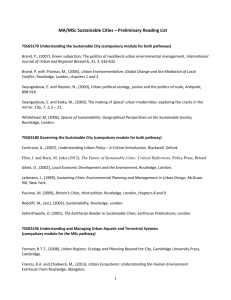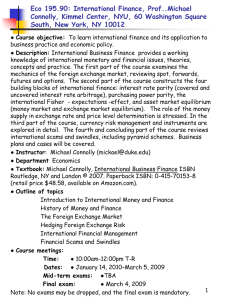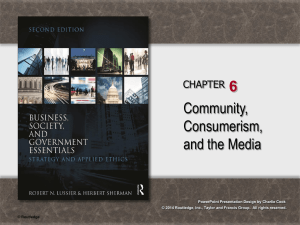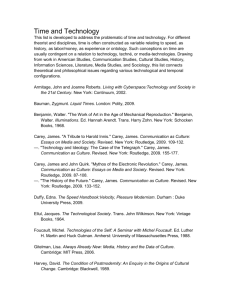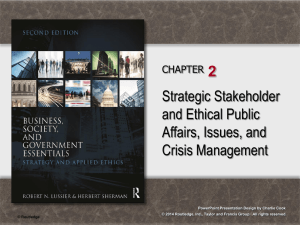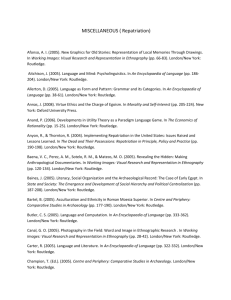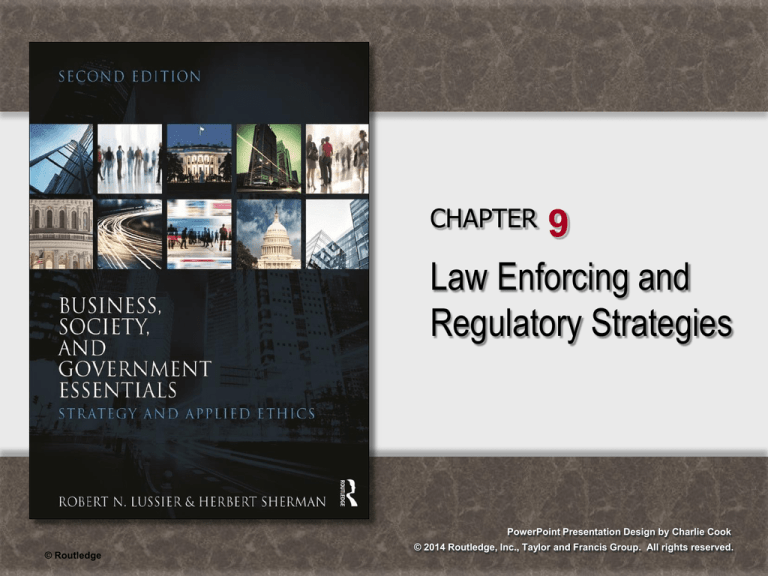
CHAPTER
9
Law Enforcing and
Regulatory Strategies
PowerPoint Presentation Design by Charlie Cook
© Routledge
© 2014 Routledge, Inc., Taylor and Francis Group. All rights reserved.
Learning Outcomes
After studying this chapter, you should be able to:
1. List the organizational structure of the federal executive branch of
government and the three primary powers of the president
2. Explain the relationship between regulatory impact analysis, the
Federal Register, and Regulations.gov
3. Describe the rule-making process
4. Compare and contrast cross-subsidization, cost-of-service regulation,
privatization, and deregulation
5. Discuss the differences in the use of campaign contributions, lobbying,
grassroots lobbying, and testimony strategies used by businesses to
influence Congress versus influencing regulatory agencies
6. Identify the role of advisors and the reasons why businesses serve on
advisory panels and committees
7. Define the key terms in the chapter
© Routledge
The Executive Branch of Government
Executive Office
of the President
Executive
department
© Routledge
Independent
Agencies and
Government
Corporations
Boards,
Commissions,
and Committees
Quasi-Official
Agencies
Executive Office of the President
Council of Economic Advisers
Council on Environmental Quality
Executive Residence
National Security Staff
Office of Administration
Office of Management and Budget
Office of National Drug Control Policy
Office of Science and Technology Policy
Office of the United States Trade Representative
Office of the Vice President
White House Office: many other entities are in the White House Office
© Routledge
Executive Departments: The Cabinet
• Department of Agriculture (USDA) • Department of Housing and Urban
Development (HUD)
• Department of Commerce (DOC)
• Department of Justice (DOJ)
• Department of Defense (DOD)
• Department of Labor (DOL)
• Department of Education (ED)
• Department of State (DOS)
• Department of Energy (DOE)
• Department of the Interior (DOI)
• Department of Health and Human
Services (HHS)
• Department of the Treasury
• Department of Homeland Security • Department of Transportation (DOT)
(DHS)
• Department of Veterans Affairs (VA)
© Routledge
Independent Agencies and
Government Corporations
• Central Intelligence Agency (CIA)
• Commission on Civil Rights
• CPSC
• EEOC
• EPA
• FCC
• FDIC
• FEC
• Federal Mediation and
Conciliation Service
• FTC
© Routledge
• National Railroad Passenger
Corporation (AMTRAK)
• National Science Foundation (NSF)
• NLRB
• Peace Corps
• SEC
• Service
• Small Business Administration (SBA)
• Social Security Administration (SSA)
• United States Postal Service (USPS)
Boards, Commissions, and Committees
•
•
•
•
•
•
•
•
•
Chief Financial Officers Council
Chief Information Officers Council
Federal Accounting Standards Advisory Board (FASB)
Federal Financial Institutions Examination Council
Interagency Alternative Dispute Resolution Working
Group
National Bipartisan Commission on the Future of
Medicare
Regulatory Information Service Center
Social Security Advisory Board
Taxpayer Advocacy Board
© Routledge
Powers of the President
Commander–inchief of military
Enforce laws as
chief executive
Propose and veto
laws as legislator
Make and break
foreign treaties and
trade agreements
© Routledge
Presidential
duties and
responsibilities
Develop the
federal budget
Act as comforter in
chief in crises
Regulatory Information
State what a
business can
and cannot do
Set standards and
specify how met
Ask for information
© Routledge
Set product and
service prices
Objectives
of rules and
regulations
Provide licenses
and permits
Give subsidies
to businesses
Benefits and Costs of Regulation
Benefits of Regulation
• Reduced prices for subsidized
commodities
• Better treatment of employees
• Safer work environments
• Safer products
• Community improvements
© Routledge
Costs of Regulation
• Increased burden and costs of
regulatory compliance
• Less product innovation
• Less new investment in plants
and equipment
• Increased likelihood of litigation
Regulatory Impact Analysis (RIA)
Statement of the
need for the
regulatory action
Examination of
alternative
implementation
approaches
Evaluation of the
qualitative and
quantitative benefits
and costs
Major Rule Proposal
Office of Management and Budget (OMB)
submits proposed and final rule
submissions to the Federal Register
© Routledge
Sources of Regulatory Information
Laws, Rules and
Regulations
Federal
Register
© Routledge
Reginfo.gov
Regulations.gov
Rule Making
• The Administrative Procedures Act (APA)
Provides for public notice and allows comments during agency
rule making, prior to agency action.
Boards, commissions, and committees, including business
interests, may give input and may lobby during the process.
• Challenging Agency Rule Legality and Enforcement
Procedural due process challenges to a rule claim that an
agency did not follow APA procedures in making the rule.
Substantive due process challenges to a rule claim that an
agency exceeded the scope of its regulatory authority in making
the rule.
© Routledge
Figure 9.7
The
Rule-Making
Process
© Routledge
Congressional Oversight of Regulators
• Maintaining Congressional Oversight
Congressional Oversight Committee
Passing of Congressional laws
Revising statutes and blocking rule changes made by regulatory
agencies
Setting budgets of agencies to expand or contract their power
Using Congressional committees to pressure agencies
Individual members of Congress may pressure agencies
Using the threat of agency reauthorization
© Routledge
Methods of Regulatory Reform
Reducing the Impact of
Rules and Regulations
Reforming
Regulation
© Routledge
Privatization
Deregulation
Reforming Regulation
More selfregulation
Eliminating
crosssubsidization
Eliminating
cost-of-service
regulation
Regulatory
Reform
Suggestions
© Routledge
Business Nonmarket and
Market Strategies and Ethics
• Regulatory Political Strategies
Business Interest Groups
Campaign Contributions and PACs
Grand Nonmarket Strategies
Lobbying
Grassroots Constituency Lobbying
Coalition Building
Testimony
Advisory Panels and Committees
© Routledge
Reasons for Business to Serve on
Advisory Panels and Committees
1. Public volunteer service helps build a
reputation for being socially responsible.
2. Serving alerts business to proposed rules.
3. Serving can lead to placing proposed rules to
benefit business on the agency’s agenda.
4. Serving provides access to regulators who will
listen to input that can influence the agency’s
decision to benefit business.
© Routledge
Key Terms
Administrative Procedures Act (APA)
cabinet
cost-of-service regulation
cross-subsidization
deregulation
executive departments
Executive Office
Federal Register
independent agencies
privatization
procedural due process
Regulations.gov
regulatory impact analysis (RIA)
substantive due process
© Routledge

